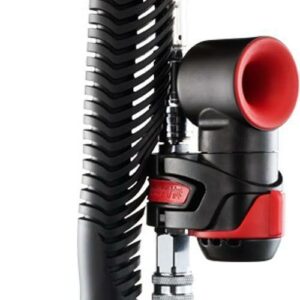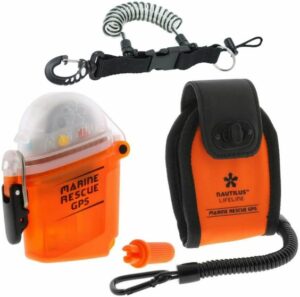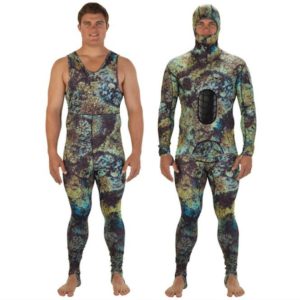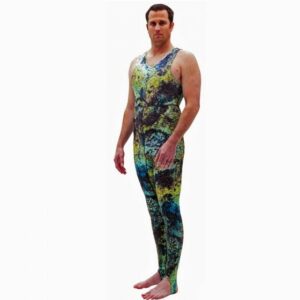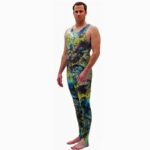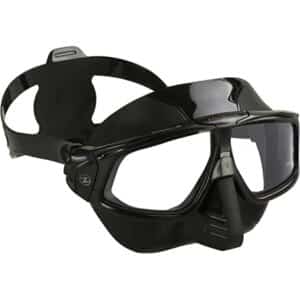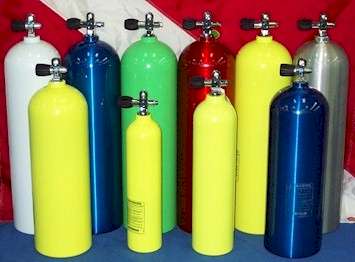
Updated September 20, 2024
Snorkeling and freediving are great sports, but unfortunately, even the best can only stay underwater for a few minutes. To stay longer, a source of air is needed. This can be achieved with a surface supply, such as a low-pressure hookah system, or more popularly with a scuba tank.
When you start shopping at Amazon or a dive shop the choices can be a little daunting. What should be considered in purchasing a tank? Which ones are suitable for your stature, style of diving, and personal air consumption?
Scuba Tank Buying Guide
Size
Scuba tanks come in a large range of sizes based on the different characteristics of people and the types of dives planned.
Pony or bail-out bottles can range from 6-40 cubic feet of air capacity and are designed to provide an extra source of air in an emergency and don’t normally need to hold a lot of air.
Most back-mounted tanks will be larger as they are meant to provide an air source for an entire dive. Typically they will be sized from 45-100 cubic feet, though may have even more capacity. The most commonly used tank is an 80 cubic foot aluminum model because it can accommodate almost any diver for the duration of a standard dive and is reasonably priced, particularly at wholesale levels that dive shops want to pay.
Students and smaller divers may find that a 63 cubic-foot tank will handle their air consumption needs, especially on shallow dives, and be less unwieldy than a bigger version.
Larger, higher air consumption divers or deep divers may opt for tanks of 100, 117, or even 149 cubic foot capacities.
Technical divers carrying differing mixtures of gas may carry several tanks of different sizes based on their dive plan and equipment configuration.
Materials
The two materials primarily used for scuba tanks are steel and aluminum. Steel is sturdy but susceptible to rust. Aluminum can’t rust but is softer and more prone to dents and dings which weaken the tank’s integrity. A new carbon fiberglass material has recently come into use which is sturdy and also very light. The Iorman Universal 95 CF Tank, one of the models I review below, uses this.
Aluminum and steel tanks when full will be negatively buoyant at the start of the dive and as air is consumed buoyancy will increase. In the case of aluminum tanks, they often become a bit positively buoyant by the end of the dive. This requires the diver to compensate, particularly on ascent or at safety stops, to keep from prematurely or too quickly surfacing. Some will choose to carry more weight to avoid this.
Further Reading: Buoyancy of Tanks
Low Pressure vs. High Pressure
The air in scuba tanks is compressed in order to be stored in a scuba tank. The pressure range is measured in psi (pounds per square inch) or bar, using the metric system. The normal range is 2,400-3,500 psi (165-240 Bar).
Tanks rated at the high end of that range, or high pressure (HP) tanks, use more material and are heavier and more unwieldy than the ones at the lower end (LP).
LP tanks are best for nitrox and technical divers who use partial pressure blending techniques to create the mix with the desired gas percentages. Most tanks in popular use are LP tanks, however, the Iorman Universal carbon fiberglass tank (reviewed below) is an HP model.
Valves
Today practically all scuba tanks use K valves, which are basic twist-on and off valves to control airflow from the tank to the regulator. They are configured to attach to the regulator with a screw-on DIN connector that is popular in Europe and among technical divers, or the yoke system favored in the U.S. Adapters are available to convert from one system to the other. The valve must turn easily and be leak-free. If this isn’t the case, then a professional technician should service it before use.
Oxygen Compatibility
Standard scuba tanks are rated for use with air, which has 20.9% oxygen. More advanced divers may start to use blends of gas that have a greater percentage of oxygen. In that case, special care needs to be taken to assure safety. This requires cleaning the tank and valve with specified cleaning agents and the use of proper lubricants and other materials. Before a tank is used for such gases, a technician is required to provide this service to meet certain standards.
Best Scuba Tanks Review
- Faber 85 CF Low-Pressure Steel Tank
- Faber 100 High-Pressure Steel Tank
- Faber Stealth HP117 Steel Tank
- Catalina 80 CF Aluminum Tank
- Iorman Universal 95 CF Tank
- Faber 149 CF Steel Tank
- Sherwood 100 CF Aluminum Tank
Faber 85 CF Low-Pressure Steel Tank
- Capacity: 85 CF (13.1 liters)
- Measurements: 25.98 inches x 7.01 inches
- Weight when empty: 37.65 lbs (17.1 kg)
- Buoyancy: -3.8 lbs (-1.72 kg) when full (positively buoyant at the end of the dive)
- Max fill pressure: 2,640 PSI/182 Bar
- Material: steel with a corrosion-resistant finish
- Comes with a pro-K valve, recent hydro
- Nitrox compatible to 40%
- Rating: 4.5
- Price: $$
Suitable for recreational and advanced divers
Faber 100 High-Pressure Steel Tank
- Capacity: 100 CF (12.9 liters)
- Measurements: 25.39 inches x 7.24 inches
- Weight when empty: 34.3 lbs (15.59 kg)
- Buoyancy: -2.42 lbs (-1.1 kg) when full (still negatively buoyant at the end of the dive)
- Max fill pressure: 3,442 PSI/237 Bar
- Material: steel with a corrosion-resistant finish
- Comes with a pro-K valve, recent hydro
- Nitrox compatible to 40%
- Rating: 5
- Price: $$$
Suitable for sport nitrox divers
Faber Stealth HP117 Steel Tank
- Capacity: 117 CF (12.9 liters)
- Measurements: 24.21 inches x 8.02 inches
- Weight when empty: 37.6 lbs (17.09 kg)
- Buoyancy: -9.12 lbs (-1.3 kg) when full (slightly positively buoyant on an empty tank)
- Max fill pressure: 3,442 PSI/240 Bar
- Material: steel with a corrosion-resistant finish
- Comes with a pro-K valve, recent hydro
- Nitrox compatible to 40%
- Rating: 5
- Price: $$$
Suitable for sport nitrox divers
- Capacity: 80 CF (11.1 liters)
- Measurements: 25.8 inches x 7.8 inches
- Weight when empty: 31.6 lbs (14.36 kg)
- Buoyancy: -5.8 (-2.64 kg) when full (positively buoyant at the end of the dive)
- Max fill pressure: 3,000 PSI/200 Bar
- Material: high-strength aluminum alloy
- Comes with a pro-K valve, recent hydro, variety of colors
- Nitrox compatible to 40%
- Rating: 5
- Price: $$
Suitable for all-round use and sidemount diving
- Capacity: 98 CF (9 liters)
- Measurements: 22.8 inches x 5.8 inches
- Weight when empty: 12.4 lbs (5.63 kg) (very light)
- Buoyancy: -5.8 (-2.64 kg) when full (positively buoyant at the end of the dive)
- Max fill pressure: 4,500 PSI/310 Bar
- Material: very durable carbon fiberglass with aluminum liner
- Comes with valve, recent hydro/DOT certification
- Rating: 4.5
- Price: $$$$
Lifesaver on ships, filling PCP rifles and paintball tanks, fire, medical protection, etc., and scuba diving
- Capacity: 149 CF (12.9 liters)
- Measurements: 29.33 inches x 8.02 inches
- Weight when empty: 46.9 lbs (21.32 kg)
- Buoyancy: -1.2 lbs (-2.64 kg) when full (still negatively buoyant at the end of the dive)
- Max fill pressure: 3,442 PSI/237 Bar
- Material: steel with a corrosion-resistant finish
- Comes with a pro-K valve, recent hydro
- Nitrox compatible to 40%
- Rating: 4.5
- Price: $$$$
Suitable for sport nitrox and deep divers
- Capacity:100 (11.1 liters)
- Measurements: 30.3 inches x 7.8 inches
- Weight when empty: 46.2 lbs (21 kg)
- Buoyancy: -7.8 lbs (-3.54 kg), (still negatively buoyant at the end of the dive)
- Max fill pressure:3300 PSI / 228 Bar
- Material: high-strength aluminum alloy
- Comes with pro-K valve, recent hydro, in multiple colors
- Nitrox compatible to 23.5%
- Rating: 4.5
- Price: $$
Suitable for recreational and deep diving
Best Scuba Tank Comparison Table
Scuba Tank Maintenance
In order for safety and tank longevity, several steps should be followed after use:
- Rinse in freshwater to remove salt and grit from the tank and valve.
- Store the tank with the valve fully closed and a medium amount of air in the tank. If the tank is full, it can weaken the structure and cause cracks, eventually. If the valve is open, contaminants and moisture can get inside.
- Store it upright or fully horizontal to avoid stress.
- Rinse and clean your regulator thoroughly with fresh water after each dive to avoid foreign materials coming into contact with the tank valve.
- Allow everything to dry thoroughly and store it out of direct sunlight, which can degrade the materials.
Feedback and Comments
I hope you found this post on scuba tanks interesting and useful. If you have any questions or ideas, please feel free to share them in the comments section. If there is no comments section directly below, click here: >>comments<<














